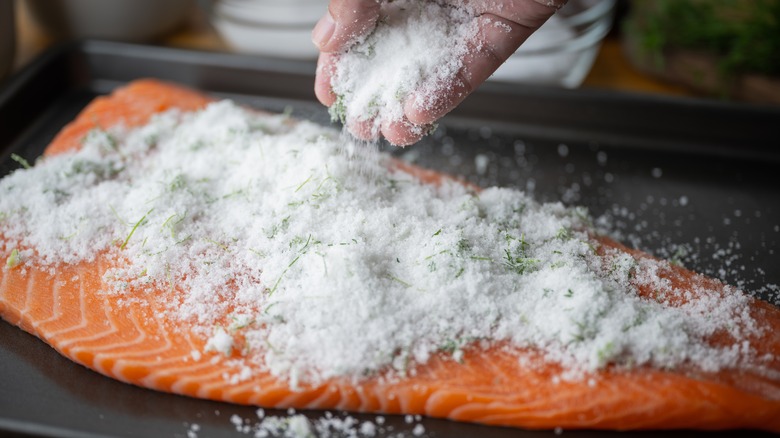What's The Difference Between Gravlax And Smoked Salmon?
If you've been to a deli or grocery store that sells various styles of salmon, you know that it can be easy to get lost in the array of varieties. There can be a wide range of geographies to choose from and a number of different preparations that only a savvy salmon shopper may be able to wade through.
When it comes to gravlax and smoked salmon, they can look extraordinarily similar. Both varieties are a bold, bright pink-orange color with a slightly oily sheen. They can also be presented in a similar way, finely cut into thin slices. So what's the difference between these look-alikes?
The primary difference between gravlax and smoked salmon is how they are prepared. Gravlax is made by curing the fish, whereas smoked salmon is, of course, smoked, resulting in subtle variations in flavor between the two. It's important to note, too, that the smoking process for salmon can involve either cold-smoking or hot-smoking, which yield vastly different results from each other in terms of texture.
What is gravlax?
Gravlax was born in the Middle Ages when Scandinavian fishermen would cure salmon by first brining, then burying it. The name itself indicates what the preservation method is, with "grav" translating to "grave" and "lax" meaning "salmon."
While some fishermen used solely salt on the filleted fish, others treated it with herbs, spices, and the salmon's blood. The fish was then buried in the sand and covered with birch bark for several days. The resulting final product was cured salmon that some liken to fermented herring.
More contemporary preparations of gravlax still take several days, but utilize the refrigerator instead of the ground. The brine itself still contains salt but also incorporates sugar, and often an element of citrus — typically in the form of lemon zest. Some preparations also include dill, horseradish, or juniper berries, and may utilize aquavit, vodka, or gin. Modern-day gravlax has a milder flavor than its Middle Age predecessor, similar to lox (though less salty) or sashimi.
What is smoked salmon?
Smoked salmon can be either cold- or hot-smoked. Cold-smoked salmon is typically brined with salt and sugar before spending about half a day in a smoker set to 80 degrees Fahrenheit or lower. Hot-smoked salmon is often first treated to a wet brine that can include water, salt, sugar, and spices before being smoked for several hours at approximately 130 degrees Fahrenheit.
Cold-smoked salmon is the variety that can be spotted on a bagel with a schmear of cream cheese. It has a mild fish flavor with notes of smokiness and salt. Meanwhile, hot-smoked salmon looks similar to salmon made using other techniques, like baking, and it is both firm and flaky.
Hot-smoked salmon is not interchangeable with either cold-smoked salmon or gravlax due to its significant textural difference from both. However, while cold-smoked salmon and gravlax do have slightly different flavor profiles, they can be swapped in recipes depending on your preference. From blinis and dip to pasta and breakfast casseroles, either one can add satisfying salmon flavor to a dish.


